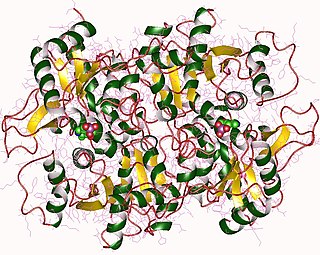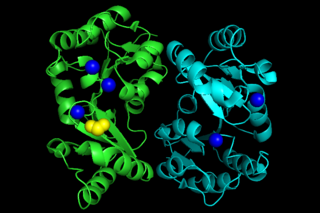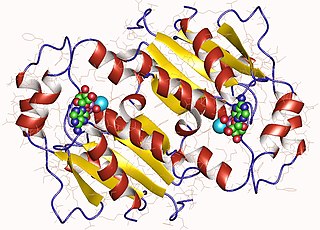| bisphosphoglycerate phosphatase | |||||||||
|---|---|---|---|---|---|---|---|---|---|
 Bisphosphoglycerate phosphatase (bifunctional) homodimer, Human | |||||||||
| Identifiers | |||||||||
| EC no. | 3.1.3.13 | ||||||||
| CAS no. | 9033-04-9 | ||||||||
| Databases | |||||||||
| IntEnz | IntEnz view | ||||||||
| BRENDA | BRENDA entry | ||||||||
| ExPASy | NiceZyme view | ||||||||
| KEGG | KEGG entry | ||||||||
| MetaCyc | metabolic pathway | ||||||||
| PRIAM | profile | ||||||||
| PDB structures | RCSB PDB PDBe PDBsum | ||||||||
| Gene Ontology | AmiGO / QuickGO | ||||||||
| |||||||||
In enzymology, a bisphosphoglycerate phosphatase (EC 3.1.3.13) is an enzyme that catalyzes the chemical reaction
- 2,3-bisphospho-D-glycerate + H2O 3-phospho-D-glycerate + phosphate
Thus, the two substrates of this enzyme are 2,3-bisphospho-D-glycerate and H2O, whereas its two products are 3-phospho-D-glycerate and phosphate.
This enzyme belongs to the family of hydrolases, specifically those acting on phosphoric monoester bonds. The systematic name of this enzyme class is 2,3-bisphospho-D-glycerate 2-phosphohydrolase. Other names in common use include 2,3-diphosphoglycerate phosphatase, diphosphoglycerate phosphatase, 2,3-diphosphoglyceric acid phosphatase, 2,3-bisphosphoglycerate phosphatase, and glycerate-2,3-diphosphate phosphatase. This enzyme participates in glycolysis/gluconeogenesis.








